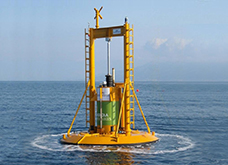Wave power is the capture of energy of wind waves to do useful work – for example, electricity generation, water desalination, or pumping water. A machine that exploits wave power is a wave energy converter (WEC).
Wave power is distinct from tidal power, which captures the energy of the current caused by the gravitational pull of the Sun and Moon. Waves and tides are also distinct from ocean currents which are caused by other forces including breaking waves, wind, the Coriolis effect, cabbeling, and differences in temperature and salinity.
Wave-power generation is not a widely employed commercial technology, although there have been attempts to use it since at least 1890.
In 2000 the worlds first commercial Wave Power Device, the Islay LIMPET was installed on the coast of Islay in Scotland and connected to the National Grid. In 2008, the first experimental multi-generator wave farm was opened in Portugal at the Aguçadoura Wave Park.
There are currently hundreds of methods for converting wave power into energy already in use across the globe, and many more theories for recovering wave energy are in the early stages of research. The Bureau of Ocean Energy Management identifies four main wave energy technologies in use today: terminator devices, attenuators, point absorbers and overtopping devices.
Waves are generated by wind passing over the surface of the sea. As long as the waves propagate slower than the wind speed just above the waves, there is an energy transfer from the wind to the waves. Both air pressure differences between the upwind and the lee side of a wave crest, as well as friction on the water surface by the wind, making the water to go into the shear stress causes the growth of the waves. More details
Wave power is distinct from tidal power, which captures the energy of the current caused by the gravitational pull of the Sun and Moon. Waves and tides are also distinct from ocean currents which are caused by other forces including breaking waves, wind, the Coriolis effect, cabbeling, and differences in temperature and salinity.
Wave-power generation is not a widely employed commercial technology, although there have been attempts to use it since at least 1890.
In 2000 the worlds first commercial Wave Power Device, the Islay LIMPET was installed on the coast of Islay in Scotland and connected to the National Grid. In 2008, the first experimental multi-generator wave farm was opened in Portugal at the Aguçadoura Wave Park.
There are currently hundreds of methods for converting wave power into energy already in use across the globe, and many more theories for recovering wave energy are in the early stages of research. The Bureau of Ocean Energy Management identifies four main wave energy technologies in use today: terminator devices, attenuators, point absorbers and overtopping devices.
